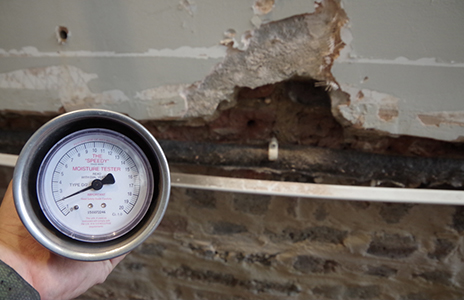Has your property been diagnosed with rising damp ?
Mike Parret, Jeoff Howel and Ray Hudson worked out what was causing dampness in buildings in the early 1990’s – but it wasn’t ‘rising damp’. Between them they lead the way for an alternative way of looking at buildings and dealing with and diagnosing their damp issues. A short film shot back then shone a spot-light on a sector of the construction industry in operating in the domestic built environment.
At the same time an old movement was promoting breathability in old buildings – the Society for the Protection of Ancient Buildings.
Has somebody diagnosed so called rising damp in your property or one that you are buying with a so called moisture meter?
If they have, they have not carried out a proper investigation, they have miss-diagnosed rising damp.
They have done this with a simple piece of equipment that is designed to measure the moisture content in timber. This piece of equipment doesn’t actually measure moisture, it measures electrical resistance; the more moisture in the timber the more resistance, this is expressed as WME (Wood Moisture Equivalent) by the manufacturer (Protimeter) and shows up as % on set of lights on the meter – Protimeter explain these readings as theoretical measurements when used on building materials other than timber. These meters are called electrical resistance type meters, but they are generally and erroneously referred to as ‘moisture meters’.
They do not measure moisture; they measure electrical resistance.
If somebody has diagnosed ‘rising damp’ with a resistance meter (erroneously called a damp meter) in your house, watch this short film shot back in the 1990’s and ask yourself ‘has anything changed’?
You can not diagnose rising damp with resistance meters and ‘theoretical measurements’. There are official documents that also state this, here are extracts from some of them:
British standard- BS 6576: Code of practice for diagnosing rising damp in walls and buildings and installation of damp-proof courses, says; ‘Electrical moisture meter…Surface measurements cannot alone give proof of rising damp, so further evidence may, where permitted, be obtained by…measurements taken within the depth of the wall. Chemical (carbide) or gravimetric methods can be used.’
British Standard – BS 5250: Code of practice for controlling condensation in buildings, says; ‘Accurate measurements of the moisture content of brick or mortar cannot be obtained by the use of electrical moisture meters because the presence of salts increases the electrical conductance of the water, giving falsely high readings. Gravimetric methods carried out on samples taken from the fabric give the most reliable results. The use of chemical (carbide) absorption type moisture meters will give a result in a short space of time and are almost as reliable.’
Building Research Establishment– BRE digest 245 RISING DAMP IN WALLS – Diagnostics and treatment says; They (resistance meters) quite commonly give high readings on the walls of old properties where some accumulation of salts occurs on internal surfaces. This does not mean, however, that the property necessarily have a damp problem: high readings can be obtained from a wall where the concentration of salts is high, even if the wall is virtually dry.’
But perhaps the most important document of the time was released some years earlier in 1986 by the SPAB; Information Sheet 4 “The need for old buildings to breathe” by P.Hughes.
Note; Some other websites are starting to show information above about measuring damp in the British Standards, however, they conveniently miss-out the use of chemical analysis of mortar samples !
The main advantage of carrying outgas carbide/ chemical analysis is, when we take samples from a wall, we analyse them there and then for their Total Moisture Content. From this we can tell wether to carry on with further investigations if the wall is damp, or not go any further if its found to be dry. With gravimetrics, the sample has to go off site and the results are not known until some time in the future – and the process is not as straightforward as on-site chemical analysis.
Here is the gravimetric process as described in BRE Digest 245
- Collect the samples in stoppered bottles and label the sample bottles.
- Weigh each sample individually on laboratory scales (weight Wo).
- Place immediately in a desiccator (humidity chamber). Allowed samples to reach equilibrium with the relative humidity in the vessel. This is a constant 75% when common salt is used.
- Re-weigh samples and recorded to see if they have gained weight or lost weight (W75).
- Place in an oven at about 50°C overnight. Remove and allow to cool. Reweigh soon after cooling (weight Wd).
- Calculate the following:
Hygroscopic moisture content at 75% RH (HMC) =
100 W75 – Wd
___________ % wet weight
W75 – Wo
Moisture content of sample when found (MC) =
100Ww – Wd
____________ % wet weight
Ww – Wo
From these weights we can then calculate the Total Moisture Content, Hygroscopic Moisture Content and Capillary Moisture Content (Free Water).
The reason for these three weights is that we want to calculate the amount of water in the samples that is present due to hygroscopic salts as opposed to water drawn into the wall via capillary action known as ‘free’ water.
Gravimetric testing will tell you if there are salts in the masonry sample. These salts can cause localised and tempoary damp patches which is more often than not caused by high humidity. Rather than going through the gravimetric process there is a very simple test we can carry out on site, we simply put the resistance meter on the masonry/plaster and if there is any salt contamination the meter will soon tell us !
Also, another of the main advantages chemical testing is that the results are recorded photographically next to the test position. This leaves no ambiguity with the results.
We, nor anybody in our peer group that carry out gas carbide testing have ever seen a genuine case of rising damp – its always something else.

See what one of our clients has to say about what we do on a damp survey ; My house has all sorts of damp problems and a damp report could have been scary and overwhelming!
If you want a full damp survey and a report that explains what’s causing any damp issues your property has, with a list of recommendations that remedies your homes problems, please feel free to contact us at;
Going on from the early days of diagnosing damp in a scientific way, Mike Parret, (along with Ralph Burkingshaw) went on to write the definitive RICS reference book Diagnosing Damp.
Jeff Howell went on to write his book – The Rising Damp Myth.
Both books are on sale at the RICS book shop:
Diagnosing Damp‘Diagnosing Damp provides you with the knowledge and tools to understand the causes of dampness in buildings and is packed full of features, diagrams and photographs to aid correct diagnosis’.
The Rising Damp Myth‘The Rising Damp Myth explains how chemical injection damp proofing is specified in around 5,000 UK properties every week by the widespread misuse of electrical moisture meters. It includes investigations into other types of damp proofing and explains how these methods too are mis-sold’.
Ray Hudson went on to set up RHL Direct producing the best whole house ventilation systems on the market.
From there on, the gas carbide meter became the definitive piece of equipment used to test masonry to see if walls were actually damp (or not) , this along with environmental assessment has helped to measure and diagnose dampness scientifically.
Building surveyors that use gas carbide meters can never seem to find the extremely rare ‘rising damp’ but conversely ones that use resistance meters find it all the time !
Standard heritages principle surveyor – Michael Foley put a question to the damp surveying world some years ago, ‘can any body provide me with a well documented and genuine case of rising damp’.
Nobody could answer the question then, and the question still remains unanswered.
If nobody can provide a well documented case of genuine rising damp, it leaves us with the question – was Jeff Howell right, is the so called ‘rising damp’ actually a myth ?
Technical Information:
